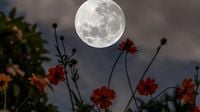As spring unfolds, stargazers are gearing up for a spectacular celestial event: the May full moon, popularly known as the ‘Flower Moon.’ This year, it will reach its peak illumination on Monday, May 12, 2025, at 12:56 p.m. EDT (5:56 p.m. GMT). However, for those who want to catch a glimpse of this stunning lunar display, the moon will appear full starting the night of Sunday, May 11, and continue to shine brightly through early Tuesday, May 13.
The Flower Moon, a name derived from the blooming flowers of spring, is also referred to as the ‘Budding Moon,’ ‘Leaf Budding Moon,’ and ‘Planting Moon’ in various cultures. This nomenclature has roots in Native American traditions, particularly from the Algonquin people, who noted the flourishing wildflowers during this time of year. According to the Old Farmer's Almanac, the full moon names come from a mix of Native American, Colonial American, and European sources.
For those hoping to witness this natural wonder, the Royal Museums Greenwich (RMG) provides some useful tips on how to best view the Flower Moon. They recommend finding a location with an unobstructed view of the horizon and suggest that using a telescope or binoculars can enhance the experience. However, a full moon can be clearly seen with the naked eye, making it accessible for all.
Interestingly, this year's Flower Moon will also be classified as a micromoon. This phenomenon occurs when the moon is at apogee, the point in its orbit where it is farthest from Earth, making it appear about 14% smaller and 30% dimmer than usual. Despite this, the moon will still offer a breathtaking sight, especially as it rises over the horizon.
In New York, for instance, the fully illuminated disk of the Flower Moon will make its appearance above the southeastern horizon at approximately 8:30 p.m. EDT on May 12. Stargazers in other parts of the world will need to check local timings, as moonrise can vary based on geographical location.
The full moon's brightness can sometimes hinder the visibility of other celestial objects. However, there will still be plenty to observe in the sky during the nights surrounding May 12. Mars and Jupiter will be visible in the western sky shortly after sunset, while the bright stars Arcturus and Spica will adorn the sky over the newly risen Flower Moon. For early risers, the moon will be found descending near the southwestern horizon as the planetary trio of Saturn, Venus, and Neptune rise in the eastern sky.
Photographers and astronomy enthusiasts alike are encouraged to take advantage of this lunar event. The RMG advises that capturing the full moon can be an enjoyable endeavor, whether using a smartphone, compact camera, or DSLR. For those aiming to photograph the moon in detail, a telephoto lens or telescope is recommended, especially if you want to include specific landmarks or features in your shots.
Moreover, the Flower Moon is not just a visual spectacle; it also holds significance in astrology. Astrologers believe that the full moon can encourage powerful shifts in relationships and personal growth. This aligns with the broader cultural interpretations of the Flower Moon as a time of renewal and awakening.
As the lunar event approaches, many are reminded of the cyclical nature of the moon and its impact on life on Earth. Full moons occur approximately every 29.5 days, typically once a month. This month’s full moon will be followed by the Strawberry Moon on June 11, 2025, and other full moons throughout the year, including the Buck Moon, Sturgeon Moon, and Harvest Moon.
In summary, the May 2025 Flower Moon promises to be a stunning sight for all who take the time to look up. Whether you’re an avid astronomer or simply someone who appreciates the beauty of nature, this full moon offers a chance to connect with the rhythms of the universe. So, grab your binoculars, find a good viewing spot, and enjoy the magic of the Flower Moon!






